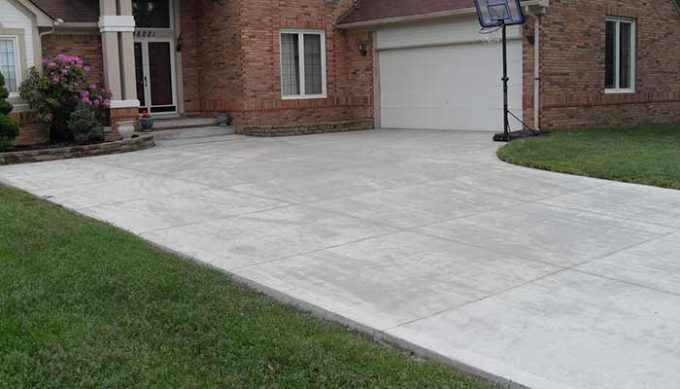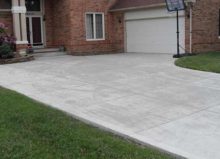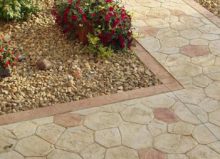Should You Repair or Replace Your Concrete?

Concrete is one of the most durable and customizable building materials available today for both commercial and residential use, but it is not indestructible. Neither is it impervious to damage from severe weather, shifting soil, heavy traffic, or the passage of time.
If you have cracks in your driveway or sidewalk, a sagging retaining wall, or a decorative patio in need of a “facelift,” the hardest decision you’ll have to make is understanding whether concrete repairs or a full replacement is the best option for your situation.
Evaluating Damage & Cause of Damage
Before fixing any concrete damage, you must first understand how severe the damage is. You can evaluate the extent of damage to your concrete structure by answering the following questions:
- Has the concrete surface of your driveway or walkway buckled enough to be a hazard?
- Does your concrete patio have a spiderweb pattern of tiny cracks?
- Has the finish of a patterned concrete pool deck or patio fully deteriorated?
- Are there visible cracks larger than a quarter of an inch, or are grass and weeds growing up through concrete joints?
- Is the concrete surface of your patio flaky, pockmarked, or scaled?
- If steps have become uneven or tilted, have they also pulled away from a vertical wall or the home’s foundation?
- Has your foundation shifted, or has your concrete driveway cracked due to shifting soils?
If you answered yes to one or more of these questions, you need to have a professional inspect your structure as soon as possible. Cracks and shifting are two of the most common problems that can occur with concrete, and can be fixed with either repairs or by replacing the entire concrete slab.
Determining whether a repair or replacement is needed is based on the severity of the damage to your existing driveway, patio, walkway, or other concrete structure.
Replacing Concrete
In most cases, a complete replacement will be the most expensive choice, involving not only the removal of damaged sections, but also site preparation and necessary labor and materials to pour and finish the new concrete. Experience and expertise are needed for large garage slabs and driveway approaches that must bear the weight of heavy vehicles.
Concrete stairs and load-bearing walls must also be designed for strength and durability. Pool decks and patios are typically designed so that rain and snow will drain off the concrete surface and away from the home, and slope can be critical to the design.
You should only replace concrete when a) the concrete structure has reached the end of its lifetime or b) when the slab itself is showing signs of structural damage. Additionally, if you receive quotes or bids from contractors, if the cost of repairs outweighs the standard cost of a replacement, you’ll save more money in the long run by opting for a full replacement. You’ll also want to consider how much material will be needed for the repairs; if more than two inches of material are needed to perform any repair, it will be more cost-effective to pay for a full replacement.
Repairing Concrete
In most cases, repairing a concrete structure will be the most cost-effective option for property owners.
Concrete repair falls into three primary categories: resealing, refinishing, and resurfacing.
- Resealing: Slight wear and tear on concrete surfaces can usually be repaired by resealing heavily trafficked areas. As a general rule, you should reseal concrete patios and walkways every few years (three to five years) as a preventive measure.
- Refinishing: Concrete refinishing changes the appearance of an existing slab; it involves sanding/grinding the top layer of concrete. Then, a concrete densifier is applied to the top surface, which fills in any holes and defects. The top layer is then reground with a polisher.
- Resurfacing: If you want to give an old slab a newer, fresher look, resurfacing can be your best option. In most instances, this will involve “roughing up” the surface by grinding off a bit of the top layer and then “frosting” the slab with a new top layer.
Even if the damage is minimal, all concrete repairs should be performed by a professional. One missed step during resealing, refinishing, or resurfacing increases the likelihood of future damages and needed repairs.
Find Your Solution With Help From G&G
To sum it up: if your concrete slab has structural damage, a replacement may be the best option for you. If there isn’t significant structural damage, resealing, refinishing, or resurfacing could be the most cost-effective solution for you.
To evaluate for structural damage, it’s best to consult with an experienced contractor like G&G Concrete & Construction.
Founded over 20 years ago, we’re a family-owned and -operated concrete repair business specializing in resurfacing, refinishing, resealing, new installations, and concrete replacements. Contact us today to request a no-obligation inspection. Our team is happy to help you find the most cost-effective solution.



